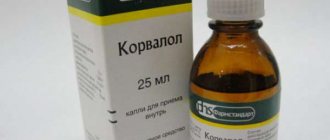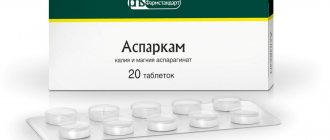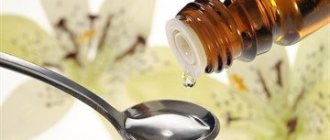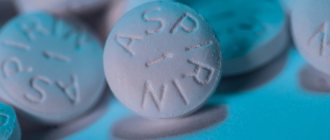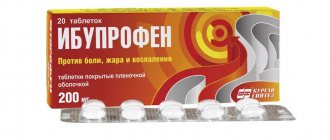- General information
- Historical facts
- Effect on the body
- How to recognize a drug addict
- Tests for Phenazepam
- How long does it stay in the body?
- How long do drug addicts live?
- Analogs
- How to speed up elimination at home
- Detoxification in hospital
- Perdose
- How to recognize and what to do
- Rehabilitation
- Coding
- Why you can’t undergo rehabilitation at home or on an outpatient basis
- Resocialization and work with codependents
- How to quit on your own
Attention! Drug use causes irreparable harm to health and poses a danger to life!
General information
Phenazepam is the first tranquilizer, which was originally used as an anesthetic for surgical procedures. Over time, the scope of application was expanded - the drug began to be included in the treatment of depression, insomnia, epilepsy, neuroses, and anxiety disorders. The drug helps relieve some clinical manifestations of withdrawal syndrome when giving up alcohol.
The drug is addictive and causes a feeling of mild euphoria. For this reason, Phenazepam is actively used by drug addicts. To enhance the effect, the medication is mixed with alcohol, sleeping pills, and other drugs.
Application
The medicine is used for certain pathologies, but with caution, strictly when prescribed by a doctor. Indications:
- insomnia, sleep dysfunction;
- treatment of muscle stiffness;
- treatment of nervous tics;
- epilepsy of temporal and myoclonic type as an anticonvulsant;
- psychoses of a reactive nature;
- schizophrenia;
- various types of neurotic states: fear, irritability, instability of a person in the expression of emotions.
Effect on the body
Phenazepam is a benzodiazepine drug, a highly active tranquilizer. It has a relaxing, antiepileptic, sedative and hypnotic effect. Due to this (provided that the medication is taken in a therapeutic dose), anxiety, excitement, and fear are reduced. Sleep gradually normalizes.
Physiological symptoms
Phenazepam in any dosage affects the qualitative and quantitative parameters of blood. With long-term use, the concentration of leukocytes, granulocytes, monocytes, and platelets in the systemic circulation decreases. Accordingly, resistance to infections - fungal, bacterial, viral - decreases, and blood clotting decreases.
Physiological symptoms of consuming large dosages include disorders of the gastrointestinal tract. Often this is nausea, vomiting, diarrhea. This is often followed by constipation. Addicts complain of heartburn, dry mucous membranes of the mouth and pharynx. The volume of saliva increases sharply. Individuals with pathological liver dysfunction may develop jaundice.
The tranquilizer and its breakdown products are evacuated from the body through the kidneys. Due to large dosages, the load on this paired organ increases. In the presence of chronic pathologies, this leads to the development of renal failure.
In women, the menstrual cycle is often disrupted. Men begin to suffer from decreased libido.
With its tranquilizing and anti-anxiety effects, Phenazepam is superior to abenzodiazepine and benzodiazepine tranquilizers.
Psycho-emotional manifestations
Frequent use of a tanquilizer has a negative effect on the central nervous system. This manifests itself in drowsiness, a feeling of weakness, and fatigue. Dizziness and migraine-like headaches are often observed. Attention and memory deteriorate, and consciousness becomes confused over time.
People dependent on Phenazepam find it difficult to navigate in space and experience muscle spasms. Muscle reactions are slow, limbs shake slightly. Behavior becomes aggressive and a suicidal component appears in it. In rare cases, hallucinations develop.
Does phenazepam increase or decrease blood pressure?
Let's consider how Phenazepam acts on the human cardiovascular system: does it increase or decrease blood pressure, in what cases can it be taken, and when should it be abandoned?
Phenazepam is a psychotropic drug. Suppresses excessive excitability of the central nervous system, eliminates feelings of fear and anxiety, and normalizes sleep. It has 2 release forms - tablets for oral administration, injections for intramuscular administration.
Composition and pharmacological properties
The active component of the drug is bromodihydrochlorophenylbenzodiazepine. Phenazepam has the following properties:
- Anxiolytic (anti-anxiety). Inhibits the activity of the area of the brain responsible for the occurrence of emotions. Thus, the feeling of fear and anxiety is eliminated.
- Calming. By suppressing emotional experiences, the functioning of the central nervous system is stabilized. The person becomes calm, less susceptible to the influence of external factors.
- Sleeping pills. Taking the drug inhibits brain activity, facilitating the process of falling asleep, reducing the frequency of night awakenings.
- Muscle relaxant. The activity of nerve cells responsible for maintaining muscle tone is inhibited.
- Anticonvulsant. Cramps are uncontrolled, painful muscle contractions. They can appear in various diseases, including hypertension. Due to the suppression of the work of nerve cells, convulsive activity is interrupted, and the risks of seizures are further reduced.
Taking Phenazepam is recommended for people with:
- mental states accompanied by increased anxiety, a feeling of fear, unstable emotionality, irritability;
- mental trauma;
- vegetative-vascular dystonia;
- hypochondriacal-senestopathic syndrome;
- increased muscle tone;
- sleep disturbance;
- nervous tic.
The effect of taking the drug is observed after 40-50 minutes. The maximum effect occurs after 1.5-2 hours. It takes a long time to leave the body (about a week). Long-term use causes lethargy, drowsiness, and inhibition of reactions.
Effect on pressure
Phenazepam lowers blood pressure, but the effect is insignificant and incomparable with the effect of antihypertensive drugs. Last no more than 2 hours.
A decrease in blood pressure occurs due to suppression of the excitability of the nervous system. After all, most often hypertensive attacks occur against a background of stress, anxiety, and emotional excitability. By depressing the central nervous system, Phenazepam eliminates the provoking factor. The result is that the pressure stabilizes and the patient’s condition improves.
But the drug has no effect on the course of hypertension. Therefore, it is not advisable to use it as a treatment for the disease. Moreover, if pressure surges are caused not by mental factors, but by others (meteorological dependence, heart pathologies), then it will not help.
Hypotonic patients are strictly prohibited from taking the medicine; it can lead to a hypotensive crisis and coma.
Mode of application
The method of using Phenazepam and the duration of its use is determined individually, depending on the type of mental disorder. For insomnia, 0.5 mg is prescribed 30 minutes before bedtime. With increased anxiety, feelings of fear, nervous excitement, the daily dosage is increased to 3 mg/day.
To achieve a quick effect, use Phenazepam solution for intramuscular administration. The maximum dosage is 5 mg/day. Injections are rarely used when psychomotor agitation cannot be left in other ways.
When taken for a long time, the drug is addictive. To prevent this, you should not take pills for more than 2 weeks.
Adverse reactions
Phenazepam may cause adverse reactions. Most often they occur at the beginning of treatment and manifest themselves as:
- fatigue;
- drowsiness;
- dizziness;
- decreased concentration;
- gait instability;
- slowing down reactions;
- confusion;
- depressed mood.
Also, the drug can cause adverse reactions from the hematopoietic organs, gastrointestinal tract, and genitourinary system. Therefore, during therapy, a person may encounter:
- anemia;
- thrombocytopenia;
- leukopenia;
- dry mouth;
- heartburn;
- decreased appetite;
- bowel dysfunction;
- jaundice;
- incontinence/urinary retention;
- decreased libido.
With abrupt withdrawal of the drug, the excitability of the central nervous system increases, which leads to irritability, nervousness, smooth muscle spasms, insomnia, tremor, and depression.
Signs of a drug addict
Phenazepam affects a person in almost the same way as alcohol - coordination of movements is impaired, speech becomes unintelligible. But there are also specific clinical manifestations:
- pale skin;
- blue corners of lips;
- pupils dilated;
- white coating on the tongue;
- dry mucous membranes.
Most Phenazepam addicts look very thin, sometimes even emaciated, due to decreased appetite. Between doses, the addict feels weak in all limbs and feels a desire to sleep.
The effect of Phenazepam on blood pressure
How Phenazepam affects blood pressure can be understood by analyzing the specific effects of the drug on the nervous and cardiovascular systems of the body. The medication relieves spasms from blood vessels and smooth muscles of the heart and brain, slows down the passage of nerve impulses, and has a pronounced calming and relaxing effect. By acting on these organs, the medication has a direct effect on blood pressure.
Does phenazepam increase or decrease blood pressure? The drug is really capable of lowering blood pressure. This effect is achieved due to the sedative, antispasmodic, relaxing effect of the drug.
With hypertension, the heart muscles work with triple effort and over time lose the ability to relax. Using the medication helps relax the heart muscles, thereby reducing blood pressure. Relieving spasms from the walls of blood vessels helps to expand their lumen. These processes lead to a decrease in blood pressure.
Increased blood pressure is often provoked by stress, nervous conditions, depression, mental stress, and an increased sense of fear and anxiety. Phenazepam helps to calm down and relax in such situations, which prevents an increase in blood pressure or helps to stop the jumps in blood pressure that have already begun.
Harm from drugs
The pronounced tranquilizing effect of the drug is especially dangerous for persons with systemic diseases of the pulmonary system, depressive disorders, liver and kidney failure.
When using Phenazepam, an allergy often develops, even if the person has not previously had any manifestations of an atypical reaction. Diuresis is impaired - the volume of urine excreted decreases. Given the fact that bromodihydrochlorophenylbenzodiazepine is excreted by the kidneys, this can lead to organ dysfunction.
The main harm from the drug is drug dependence. The main component of the drug affects certain areas of the brain and the transport function of the central nervous system. Because of this, their work and structure changes.
Phenazepam analogs
Analogues of the drug, which are completely identical in their action, include the following:
- Fenzitate;
- Tranquesipam;
- Elzepam.
There is also a group of medications that are slightly weaker in effect, but also have fewer side effects. You can buy them at the pharmacy without a prescription. Among them:
- Glycine;
- Sonapax;
- Melaxen;
- Etaperazine;
- Adaptol.
Persen night can be used as a sleeping pill instead of Phenazepam. It is slightly weaker in action, however, and not so harmful to the body.
Consequences of long-term use
If Phenazepam is taken for a long period of time in dosages exceeding therapeutic ones, the side effects intensify. For example, the manifestations of allergies become more pronounced. Quincke's edema is often associated with itching and peeling of the skin.
Angioedema is dangerous due to respiratory arrest and, as a result, death. While taking a tranquilizer, the risk increases.
Phenazepam worsens the quantitative and qualitative characteristics of blood. After cancellation they are restored. But the long stay of bromodihydrochlorophenylbenzodiazepine in the body makes this impossible. Therefore, drug addicts often get sick, their blood clotting is impaired.
Addicts suffer from severe headaches and find it difficult to retain even small amounts of information in their memory. Over time, independent movement becomes problematic due to developing problems with orientation. Muscle pain increases. Unpleasant sensations that cannot be relieved force you to take a new dose.
Phenazepam, taken in large dosages and for a long time, causes disorders of the cardiovascular system - surges in blood pressure, tachycardia.
Drugs for tachycardia with high blood pressure
It is possible to stop tachycardia and blood pressure through conservative treatment. When choosing a medicine for tachycardia with high blood pressure, the physician takes into account the severity of hypertension and the individual characteristics of the patient.
To stabilize the functioning of the cardiovascular system, you can use sedative medications, cardiac glycosides, and thyreostatic tablets. High blood pressure can be controlled through the use of beta-blockers, diuretics, calcium antagonists, ACE inhibitors and sartans.
In case of hypotension (low blood pressure) against the background of tachycardia, treatment tactics are adjusted. In this case, the use of antihypertensive medications is strictly prohibited.
Tachycardia is a pathology in which a person experiences rapid heartbeat, accompanied by severe pain in the sternum. The disease often occurs against the background of arrhythmia, heart failure, VSD, hypertension and bradycardia.
There are sinus and paroxysmal tachycardia. The principles of treatment for diseases are slightly different. So, what is sinus tachycardia? To understand this, you need to remember that there is a so-called sinus node, which sets the heart rate (heart rate).
If the operation of the node is disrupted, then tachycardia develops. Moreover, the disease is a consequence of other pathologies, including myocarditis, coronary artery disease, heart failure, arrhythmia, and VSD. With sinus tachycardia, the heart rate exceeds 90 beats per minute.
What is paroxysmal tachycardia? This concept refers to a disease in which there is a violation of the pre-gastric node. This type of tachycardia may be a consequence of:
- Pathologies of the endocrine system.
- Oxygen starvation.
- Lack of calcium and potassium in the blood.
Ventricular paroxysmal tachycardia also occurs. It can be a consequence of heart defects, heart failure, coronary heart disease, inflammation of the heart muscle, and overdose of glycosides.
How to treat tachycardia with high blood pressure? You can normalize your heartbeat and blood pressure with the help of sedatives. They are inexpensive and have a gentle effect on the cardiovascular system.
How Phenazepam affects blood pressure can be understood by analyzing the specific effects of the drug on the nervous and cardiovascular systems of the body. The medication relieves spasms from blood vessels and smooth muscles of the heart and brain, slows down the passage of nerve impulses, and has a pronounced calming and relaxing effect. By acting on these organs, the medication has a direct effect on blood pressure.
DETAILS: Tachycardia: what to do when symptoms appear?
With hypertension, the heart muscles work with triple effort and over time lose the ability to relax. Using the medication helps relax the heart muscles, thereby reducing blood pressure.
Increased blood pressure is often provoked by stress, nervous conditions, depression, mental stress, and an increased sense of fear and anxiety. Phenazepam helps to calm down and relax in such situations, which prevents an increase in blood pressure or helps to stop the jumps in blood pressure that have already begun.
Analogues of the drug, which are completely identical in their action, include the following:
- Fenzitate;
- Tranquesipam;
- Elzepam.
There is also a group of medications that are slightly weaker in effect, but also have fewer side effects. You can buy them at the pharmacy without a prescription. Among them:
- Glycine;
- Sonapax;
- Melaxen;
- Etaperazine;
- Adaptol.
Persen night can be used as a sleeping pill instead of Phenazepam. It is slightly weaker in action, however, and not so harmful to the body.
Danger of consumption methods
Phenazepam is presented on the pharmaceutical market in two forms - tablets and solution for injection. If you strictly follow the instructions and medical recommendations, these methods of use do not pose any danger.
When administered orally in large doses of Phenozepam, it accumulates in the liver and bloodstream. Because of this, damage to the gastrointestinal tract occurs. The course of chronic pathologies may be aggravated.
The most popular and frequently used method of administering the drug among drug addicts is injection. Due to chronic use, peripheral veins become sclerotic. Not only pharmaceutical solutions can be used for injections. Sometimes they are prepared independently by dissolving the tablets in saline solution. The danger is that additional ingredients often block the pulmonary capillaries, which causes chronic inflammation and granulomatosis.
Drug overdose
The average daily dosage of Phenazepam is 5 mg. Addicted people consume several times more in the same period of time to achieve the desired effect. This leads to severe intoxication, which manifests itself in deep disorientation in space, accompanied by delusions and hallucinations. Psychosis often develops. The most dangerous signs are slowing of external respiration, dysfunction of the heart and kidneys.
If, in case of a severe overdose, medical assistance is not provided in a timely manner, deep depression of consciousness develops, but with preservation of reflexes. The person then falls into a coma.
Main reasons
A number of factors contribute to the development of intoxication. For example, a patient independently taking a dosage that exceeds that prescribed by a doctor. More often this happens due to the ineffectiveness of the therapeutic course. But the excess must be systematic.
The desire to commit suicide leads to an overdose. It is known that Phenazepam often causes suicidal thoughts and depression, and therefore is not prescribed to patients with severe forms of mental disorders.
Another reason is the simultaneous use of Phenazepam and alcohol, antidepressants, analgesics, and sedatives. They enhance the developing effect of euphoria, forcing you to take increasingly larger doses.
First aid
When the first signs of an overdose appear, it is important to call an ambulance. If the person is conscious, they induce vomiting. To do this, you can give a weak solution of potassium permanganate to drink. Then they give a sorbent - Activated carbon, Enterosgel, Smecta, Polysorb. Drugs of this type collect the remnants of Phenazepam metabolites and remove them naturally. If vomiting cannot be induced, take a laxative or give a cleansing enema.
If the victim loses consciousness from time to time, he is allowed to sniff cotton wool soaked in ammonia. Patting the cheeks and also rubbing the ears are effective. You can also try having a distracting conversation.
Health care
In the event that it was not possible to cleanse the intestines at home, this procedure is carried out by employees of a specialized team, introducing water through a tube. To clean the circulatory system, saline and glucose are administered.
After stabilization of the patient's condition, he is sent to the hospital. Here they continue to cleanse the body with NaCl and glucose. Be sure to add Anexat or any other drug containing flumazenil to the solution.
Consequences of lack of help
Drug intoxication threatens the development of dangerous complications. The use of Phenazepam in large doses affects the respiratory system. More often this manifests itself in secondary pneumonia.
Failure to provide assistance causes cerebellar ataxia, which manifests itself in impaired coordination of movements. Another consequence is inflammatory damage to the kidneys, since Phenazepam is excreted by the kidneys.
Other consequences include:
- depression, anxiety;
- functional liver damage.
Other phenomena may be observed. It all depends on how long ago the addiction was formed and what doses were administered. The presence of chronic pathologies is also important.
Lethal dose
Phenazepam is taken regardless of food intake in dosages selected by the doctor taking into account the severity of the condition. Volumes of the drug for various disorders according to the manufacturer’s recommendations:
- anxiety attacks - up to 2 mg per day;
- neurotic disorders - from 0.5 to 1 mg two or three times a day;
- sleep disorders - 0.25-0.5 mg half an hour before bedtime;
- epilepsy - 2–10 mg per day;
- muscle tone, central nervous system damage - 2-3 mg twice a day;
- abstinence – 2–5 mg per day.
Exceeding the maximum daily dosage of 10 mg can lead to coma - superficial and deep. Further increase in volume leads to death.
How to terminate
Even after carrying out the necessary medical protocols for intoxication with Phenazepam, some of the metabolites remain in the body. To completely stop their negative effects on the body, an antidote, flumazenil, is administered.
This drug has a blocking effect on receptors that are affected by drugs of the benzodiazepine group. Initially, 200–300 mcg is administered. You can give no more than 2 mg again. Limitation: individual intolerance.
The antidote is administered exclusively in a hospital setting. If the victim has epilepsy, taking Phenazepam reduces the body's convulsive readiness. A developed seizure can develop into status epilepticus.
Withdrawal
In medicine, this condition is called withdrawal syndrome. It develops after the previous dose wears off or the addict begins treatment. The risk of development is higher, the larger the volume taken and the period of use.
In the structure of the syndrome, two groups of disorders are distinguished:
1. Mental:
- irritability;
- tension;
- depressed mood;
- anxiety;
- agitation or lethargy;
- increased fatigue;
- depersonalization;
- decreased quality of sleep, nightmares.
2. Somatoneurological:
- increased sweating;
- tachycardia;
- decreased blood pressure;
- dizziness;
- headache;
- paresthesia, hyperesthesia;
- hot flashes of chills.
Often, drug addicts develop small-scale tremor of the fingers when they stretch their arms. Coordination of movements is impaired, speech is difficult. On days 2–3, fibrillary twitching of the muscles of the face, upper and lower extremities begins. Convulsive seizures and psychosis may appear.
The duration of withdrawal symptoms when stopping Phenazepam is about 30 days. Upon completion, physical and psychological exhaustion, lethargy, and weakness are clearly expressed.
How to ease withdrawal symptoms
During withdrawal symptoms, the drug addict should be placed in an inpatient unit at a specialized clinic. Under constant medical supervision, the concentration of Phenazepam is gradually reduced, since sudden withdrawal will lead to the collapse of internal organs. In parallel with this, the person attends psychological trainings, where he learns to deal with anxiety, depression and suicidal thoughts.
To relieve the clinical picture, a course of flumazenil or other drugs based on this substance is carried out. They eliminate the inhibitory effect on the central nervous system, especially drowsiness. If decreased diuresis is observed, it is increased with diuretics (for example, Novurit).
In case of severe poisoning with Phenazepam, hemodialysis is indicated.
Composition and release form of the drug
The active component of the drug is bromodihydrochlorophenylbenzodiazepine. Additional elements include:
- lactose;
- potato starch;
- povidone;
- calcium stearate;
- talc.
Produced in the form of a solution (ampoules of 1 ml), as well as tablets. The pills have a round shape, white color and a dividing dosage line.
One package contains 10, 50, 100 ampoules or 50 pills. Tablets are produced in dosages of 0.5 mg, 1 mg. and 2.5 mg. One ampoule can have a concentration of 0.1 or 3%.
The price of a pack of 50 tablets with a dosage of 1 mg is 125-145 rubles. The price of a package of medicine with a dosage of 2.5 mg varies within 180 rubles. The cost of a set of 10 ampoules is about 160 rubles.
Excretion from the body
Antibodies and metabolites of Phenazepam are stored in various biological materials and tissues. The half-life ranges from 6 to 18 hours. In the blood and urine, the content of the drug decreases by half after 12 hours. If the volume of the substance does not exceed 2 mg, the body will take about 3 days to completely eliminate it.
In hair and nails, Phenazepam metabolites are detected by laboratory tests for up to 3 months.
The process of cleansing the body is influenced by several factors:
- metabolism;
- taking other medications;
- age;
- individual characteristics of the nervous system;
- the presence of chronic kidney and liver damage.
How to speed up elimination from the body at home
It is impossible to completely cope with the negative impact of Phenazepam and its metabolites on internal organs at home. Independent actions should be limited to gastric lavage.
For this procedure, you can use a solution of activated carbon, at the rate of 1 g per kilogram of weight, and 300 ml of water. You can also use soda - 2 liters of liquid and 1 tbsp. l. If a person does not experience attacks of nausea or vomiting, he is given Magnesium Sulfate according to the instructions.
Detoxification in hospital
Cleansing in a medical facility begins with gastric lavage if the patient was brought in from the street or it was not possible to carry out the procedure at home. If a person is unconscious, first intubate the trachea and remove accumulated vomit and mucus.
It is advisable to lavage the stomach and take enterosorbents if no more than 10 hours have passed since the last use. For enterosorption, the following drugs are most often used:
- colloidal silicon dioxide;
- povidone;
- polymethylsiloxane polyhydrate.
Before use, these drugs are dissolved in 100 ml of boiled water at room temperature.
After cleansing the intestines, 0.3–0.6 mg of flumazelin is administered intravenously. Additionally, a solution of electrolytes at the rate of 10–20 ml per 1 kg of weight. To relieve the clinical picture of acute poisoning, a dropper with meglumine sodium succinate is recommended. Thiamine and pyridoxine support a weakened immune system. Nootropic drugs (for example, piracetam) help eliminate disorders of the central nervous system.
In severe cases, detoxification involves the use of the following drugs:
- potassium chloride solution (only if diuresis is not impaired);
- magnesium sulfate solution;
- colloid solution;
- a nicotinic acid;
- ascorbic acid;
- cyanocobalamin;
- thioctic acid;
- ademetionine.
The dosage of these drugs is determined only by a doctor.
Hemosorption or plasmapheresis may be required. Additionally, symptomatic treatment of complications is prescribed.
Drug test
The study of biological materials - urine, blood, saliva, as well as tissues - hair, nails is required when applying for work in law enforcement agencies, studying at universities of the same system. But the primary task is the choice of therapy to eliminate the clinical picture of withdrawal syndrome or intoxication.
Types of tests
To confirm the fact of the use of street and pharmaceutical drugs, biological fluids and tissues are studied using chemical and toxicological analysis methods:
- ELISA (enzyme-linked immunosorbent assay);
- GLC (gas liquid chromatography);
- TLC (thin layer chromatography);
- GC/MSS (GC/MSS);
- IHR (immunochromatography);
- HPLC (high performance liquid chromatography).
Urine is examined using the IHR method. Test strips are used, which are immersed in material collected in the laboratory. Analysis only confirms the fact of use. The result will be reliable if it is carried out no later than 72 hours from the date of the last dose.
Blood is examined using two methods:
- Quarterly test - complements the result of urine analysis. Confirms the use of a narcotic drug (street or pharmacy origin) even after 4 months have passed since the last injection. It is important to remember that the quarterly test does not detect the drug itself, but its antibodies.
- Chemical-toxicological methods. They make it possible to confirm the fact of use if no more than 48–72 hours have passed before the analysis. Certain methods make it possible to establish a quantitative relationship. The results have legal force.
Saliva is studied by immunochromatographic analysis, chemical-toxicological method, and also using a hardware analyzer. In the first case, it is possible to obtain only preliminary results. For confirmation, a mixed method is often used - gas chromatography/mass spectrophotometry (GC/MS). Another accurate method is the Drager Drug system. It consists of two parts, which are completely hygienic. The likelihood of error is minimized and can only occur if the laboratory technician is inexperienced.
The GC/MS method is used to study hair and nails. To process samples, organic solvents are used that affect only the protein component.
Suitable for home use, as part of inspections in educational institutions, the army, and in places where there are large concentrations of young people with a high risk of drug distribution. Freely sold in pharmacy chains. Examples of some tests with indication of brands:
- Bio Group Medical System Srl (Italy);
- Teco Diagnostics (USA);
- Alfa Scientific Designs (USA);
- Oranoxis (USA);
- Diagnosis (Poland);
- Easy Healthcare (USA).
The material for rapid tests is urine. It should be collected in the morning, taking only the middle portion - it is the most concentrated. The results are preliminary.
Is it possible to cheat the test?
Often, addicts dilute the collected urine with water, citric acid or vinegar. This allows you to influence the results of tests that are collected at home.
Numerous forums recommend taking 3-4 tablets of vitamin B. Most metabolites are destroyed when the temperature rises, so some drug addicts take a hot bath or visit a sauna before taking tests.
Analogues and their dangers
Bromodihydrochlorophenylbenzodiazepine is included in a large number of drugs that are analogues of Phenazepam. In some, the concentration of the active substance does not exceed the recommended daily dose, so they are not considered a pharmaceutical drug. The most dangerous analogue is Fenzitate. It has a composition similar to Phenazepam. Long-term use causes severe liver and kidney damage and drug addiction.
Alprazolam is also a tranquilizer, a benzodiazepine derivative. As in the case of an overdose of Phenazepam, taking large doses of this drug causes suicidal thoughts, outbursts of aggression, confusion, and increased excitability.
Bromazepam, taken in small doses, has an anxiolytic effect on the body. And if the recommended volume is exceeded, it is sedative and muscle relaxant. High risk of developing addiction.
Gidazepam differs from other tranquilizers in the family by the absence of a hypnotic effect. The danger of the drug appears when combined with ethanol and antipsychotic drugs, as it leads to increased effects on the central nervous system.
Indications for use of the drug
Due to the peculiarities of its effect on the body, the medication is indicated in the following cases:
- Short-term psycho-emotional disorders.
- Impaired functioning of the central nervous system.
- Prolonged unreasonable feeling of irritability.
- Excessive feelings of anxiety or tension.
- Frequent mood swings.
- Sleep disturbance.
- Periodic paranoid anxiety.
- Pathology of the functioning of the biliary tract.
- Hypochondria.
- Treatment of chronic alcoholism.
- Epilepsy (to relieve seizures).
- Muscle stiffness.
- Hyperkinesis.
- Autonomic disorders.
- Hypertension.
It can be used before major surgery to quickly calm the patient and make him relax.
The drug Phenazepam is a strong tranquilizer. Therefore, its use is allowed only according to medical prescription and in a strictly specified dosage.
Drug addiction treatment
If, based on test results, dependence on Phenazepam has been confirmed, it is important to start therapy in a timely manner. This will help reduce the negative impact of tranquilizers on internal organs, the central nervous system and reduce the risk of death. The only antidote is flumazeline. At the same time, the dose of Phenazepam is gradually reduced, bringing it to a safe daily dose.
The tranquilizer is completely discontinued as soon as the drug addict’s condition has stabilized.
Detoxification is carried out simultaneously with drug therapy. In the case of benzodiazepine tranquilizers, the following methods can be used:
1. Forced diuresis
The patient is given a diuretic intravenously. Typically these are sodium chloride and glucose. Before prescribing this method, the drug addict's medical history is examined for the presence of chronic kidney damage. The volume of urine excreted is also taken into account. During the drip, the condition is carefully monitored.
2. Enterosorption
Fanezapam is absorbed by the walls of the stomach. The faster you rid the digestive system of benzodiazepine, the faster the condition will stabilize. In a hospital setting, an enema or probe is usually used. Additionally, a sorbent is given, which enhances the effect of drugs for cleaning the gastrointestinal tract.
3. Hardware blood purification
Tranquilizers negatively affect the liver. Blood purification together with hepatoprotectors helps restore the functioning of the organ. There are several options:
- hemosorption - a certain volume of blood is passed through a filter and then introduced into the body;
- plasmapheresis - the cell mass separated from the plasma is diluted with physiological solution in a ratio of 1 to 1 and also injected into a vein.
When taking tranquilizers in large quantities, the central nervous system is primarily affected. To restore it, a course of vitamin therapy is carried out using B vitamins. Additionally, the treating physician may prescribe limontar to restore energy metabolism, and piracetam to improve blood supply to the brain.
How addiction is formed
There are three stages in the development of drug addiction. The first is psychological. At this stage, a person forms a clear “drug-pleasure” connection. But over time, tolerance decreases and a larger volume is required to obtain the same sensations. Without another injection, it becomes more difficult for addicts to perform their duties at work.
The second stage is physical dependence. Functional disorders may appear, which are better known as withdrawal syndrome or “withdrawal.” The severity of the clinical picture depends directly on individual characteristics.
The third stage is the final stage. The body often experiences irreversible mental and physical changes. Interest in the surrounding world is lost, behavior is not controlled.
How long do drug addicts live?
Phenazepam itself cannot cause death, even if taken in non-therapeutic dosages. The risk of death is high for drug addicts with a large number of chronic diseases. Age is also of great importance - the older the addict, the faster his internal organs will fail.
A fatal outcome is most likely due to withdrawal symptoms. The clinical picture of withdrawal syndrome is accompanied by a large number of unpleasant and painful sensations. To eliminate them, too large a dose is administered, which leads to death. The outcome is also affected by the simultaneous use of alcohol, analgesics and narcotic components.
Rehabilitation
Drug addiction therapy is a complex undertaking. This means that along with drug treatment, the addict needs serious psychological support. This is the only way to achieve remission and reduce the risk of returning to drugs.
During group and individual meetings with a psychologist, the reasons that prompted a person to take a pharmaceutical drug are determined. Scenarios for safe solutions must be worked out. They also pay attention to the analysis of the sensations that the addict experienced while taking Phenazepam, and possible ways to obtain them using healthy methods.
Non-drug methods are also effective in rehabilitation. For example, yoga classes.
Why you can’t treat yourself at home
Like other drugs that affect the central nervous system, Phenazepam should be discontinued gradually. A sharp refusal increases aggressiveness and suicidal thoughts. Such conditions require adequate actions, the implementation of which requires specialized education.
Phenazepam intoxication is often accompanied by severe headaches. It is impossible to treat them with standard drugs. This may lead to you taking another dose.
Working with codependents
In addiction treatment, codependents are usually called people who live directly with an addict. This could be parents, wife/husband, children. Over time, they cease to adequately respond to drug addiction, often finding excuses for it. In such conditions, it is impossible to achieve stable remission.
Rehabilitation centers are developing special programs for codependents. They involve working with a psychologist, lectures and meetings. All information related to dependence on Phenazepam must be presented. The main task is to achieve persistent rejection of the current situation.
Ambulatory treatment
Another part of drug addiction treatment. This stage is started only if there is psychological readiness of the drug addict, his family and successful completion of the medication program. By the time outpatient treatment begins, a person must completely stop communicating with people who drink alcohol, use drugs, or smoke.
The duration of the course can be up to six months. It is mandatory to visit a narcologist or psychologist throughout this time according to the established schedule. And also take vitamins, maintain a healthy lifestyle and adhere to the rules of a balanced diet. Listening to thematic seminars, lectures, meetings with former drug addicts who have successfully recovered from addiction are also part of outpatient treatment.
Resocialization
During the time when a person is dependent on drugs, he loses his previous social connections, work or study. Without returning to society, it is impossible to achieve remission. Resocialization usually occurs in two stages.
The first one is group. Former addicts who have successfully completed treatment live in small groups outside the rehabilitation center. Here they learn to be members of society, interact with each other, and perform certain duties. Retraining courses can be organized.
The second stage is home. Without a program for working with codependents, it is not advisable. If yesterday's drug addict is not supported by loved ones or he returns to his previous environment, there is a high risk that addiction will develop again.
How to quit on your own
Any self-medication entails serious consequences. Drug addiction is no exception. Patients often refuse to go to a medical facility for fear of publicity. But it is impossible to cope with withdrawal symptoms without medical supervision. Mental problems in this case will only get worse, which, against the background of suicidal thoughts after taking Phenazepam, can lead to death.
The addict may try to cut ties with others who also use drugs or alcohol. But it is extremely difficult to do this without the support of a psychologist.
Bibliography:
- Intravenous drug administration.
- Principles and stages of the treatment and rehabilitation process in narcology.
- Federal clinical guidelines for the diagnosis and treatment of withdrawal syndrome.
- Author Veronica Dovnich
Editor Artyom Emelyanenko
Contraindications and side effects
Phenazepam has many contraindications and a high risk of side effects, even with slight violation of the doctor’s instructions. Self-medication is strictly prohibited. Contraindications include:
- Depressive states. In medical practice, a huge number of cases have been recorded in which, after stopping the drug due to depression, people tried to commit suicide.
- Increased intraocular pressure, myasthenia gravis, angle-closure glaucoma.
- Age under 18 years, pregnancy and lactation period.
- Impaired kidney or liver function.
Side effects of the medicine include:
- suppression of the central nervous system, the occurrence of lethargy, impaired mental activity and coordination, lethargy and excessive drowsiness.
- heartburn, nausea, drooling;
- allergic skin manifestations;
- heartbeat disturbance;
- deterioration of visual acuity;
- decreased blood pressure;
- headache.
The drug should be used with caution in old age, people with liver or kidney failure, and organic brain damage. When asked whether it is possible to take Phenazepam tablets for high blood pressure, the answer is yes, because the drug slightly reduces blood pressure.
Due to low concentration, driving is prohibited during treatment.
With long-term treatment, drug dependence may develop. If you stop taking it abruptly, insomnia sets in, the person becomes irritable and nervous, and their mood worsens.
